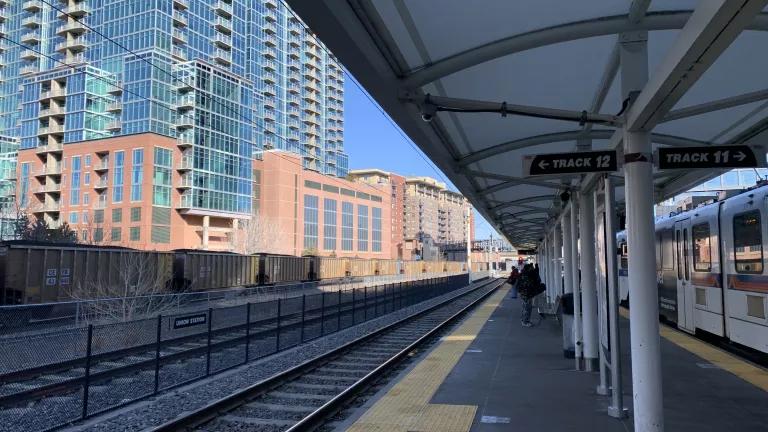Colorado Proposes Shift from Highway Expansion to Transit
In what would be a win for climate, equity, and all Coloradans, the Colorado Department of Transportation has proposed canceling two highway widening projects in the Denver region and reallocating resources to transit.

I-25 in Denver
UPDATE: On September 15, 2022, the CDOT Transportation Commission approved the revised 10-year plan, described below.
In what would be a win for climate, equity, and all Coloradans, the Colorado Department of Transportation (CDOT) has proposed canceling two highway widening projects in the Denver region, most notably I-25 through central Denver, and reallocating resources to transit. The proposal represents a promising shift in rethinking the role of a state transportation department, alongside similar shifts we have seen at the federal Department of Transportation: instead of a focus on expanding highways so cars can move quickly, invest in people and communities by expanding safe and affordable transportation choices such as transit, walking, and biking.
When we talk about highways, we need to consider their impact on surrounding communities, often communities of color and low-income communities. When America’s highway system was built decades ago, highways were often sited in low-income communities as part of “urban renewal,” but in reality, their construction ravaged neighborhoods, displaced residents, and divided communities. That legacy wears on, as traffic on the highways produces high levels of dangerous air pollution. For instance, the neighborhoods along Denver’s I-25 and I-70 highways have much higher rates of children being hospitalized for asthma. Sun Valley, where the expansion of central I-25 is being reconsidered, already has one of the highest rates of asthma in the city. Residents of Sun Valley have been active in opposing expansion of I-25 through their neighborhood, and it is encouraging that CDOT is listening to them.
Expanding highways and roadways is also at odds with addressing climate change. As NRDC and others have demonstrated time and time again, expanding roads results in more people driving, which results in increased emissions. The well-proven phenomenon is known as induced demand: Because congestion is temporarily reduced with an additional lane, driving becomes a more attractive option, so more people drive, quickly making the road congested yet again with the additional cars. For example, after $1.6 billion dollars was spent on widening I-405 through Los Angeles, travel times actually increased at all times of day. All that driving has a big impact on climate emissions, with transportation being the highest source of greenhouse gas emissions in Colorado and the country.
Enter Colorado’s new greenhouse gas rule for transportation. In December 2021, CDOT adopted a new planning standard that requires the state and regional transportation plans to reduce greenhouse gas emissions. CDOT and regional planning organizations, such as the Denver Regional Council of Governments, now must model transportation projects, and those projects must not exceed allocated greenhouse gas emissions. If the projects are expected to exceed the limit, they must be eliminated, altered, or accompanied by emissions-reducing mitigation measures like transit or land use changes. Ultimately, the outcome of the rule could be a changed mix of transportation projects that CDOT and regional planning organizations propose and build.
In the recently updated version of CDOT’s proposed 10-year plan, central I-25 expansion through Denver is crossed off; instead, $35 million is being shifted to “non-capacity safety and operational improvements” on the highway, along with an additional and expedited $100 million for regional bus rapid transit. Bus rapid transit offers a tremendous opportunity for the Denver region, moving more people more efficiently, expanding access to jobs and opportunities, connecting communities, and making transportation more affordable and accessible. These and other multimodal improvements are exactly the investment that Denver and Colorado need to address our climate, air quality, and affordability crises.
For decades, state departments of transportation have seen their role as solely to build and maintain highways. Regions have been built so that people must generally drive everywhere for every trip. This forced dependency has come at a cost to our health, our communities, and our climate. It is not easy to dramatically change budgets, project pipelines, or long-held philosophies, but Colorado’s transportation greenhouse gas rule and recent project shift show that it is possible. I hope that CDOT’s transportation commission approves the revised plan when it votes next month, and I hope CDOT continues to innovate and think critically about what will best serve our future. Other states that are serious about tackling climate change and reinvigorating communities should also be watching Colorado.




